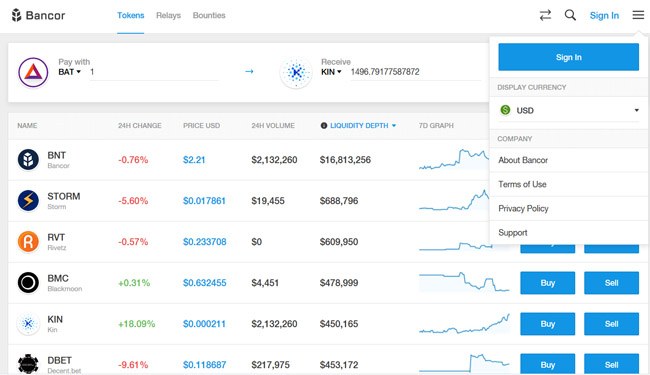The Bancor Protocol is a method that was created to allow anyone to quickly and easily convert any ERC-20 currencies directly between each other as opposed to using a third-party exchange to accomplish the conversion.
In addition to the actual protocol that utilizes smart contracts to function, the project also has its own network that negates the need for matching buyers and sellers to create liquidity. The network uses the smart contracts and a new type of token called a “Smart Token” to function. The very first Smart Token was the native Bancor Network Token, which was created to help minimize the number of conversion made on the network to convert various tokens and coins.
The Problem Addressed by the Bancor Protocol
One of the primary issues being addressed by the Bancor Protocol is the illiquidity seen in the cryptocurrency markets. The largest coins like Bitcoin and Ethereum obviously don’t suffer from liquidity issues as there are always buyers and sellers for the largest cryptocurrencies. However, out of the thousands of other tokens that have been created, most do suffer from illiquidity. This isn’t because these tokens and coins are bad, rather it’s because they simply haven’t gained enough market attention yet to become liquid.
Liquidity is determined by the volume of coins available for sale and purchase, with the goal to be a consistent supply of buyers and sellers for a particular asset or token. Any token that has good liquidity is one you can buy or sell at any time, without having to worry about delays or huge price gaps. Tokens that suffer from low liquidity are just the opposite. They often suffer from large price gaps, and there may be times where it is not possible to buy or sell the token due to the lack of a counter-party.
The Bancor team would have us believe that because the majority of tokens are illiquid and difficult to exchange they are also excluded from the internet of value. The Bancor Protocol is attempting to do away with liquidity issues for all ERC-20 tokens.
The ultimate goal of the Bancor team is a world where you could have millions of tokens that are either locally used or niche projects, but still tradable quickly and easily on a global basis.
Bancor Protocol Review: The Bancor Protocol and Smart Tokens
The smart contracts in the Bancor Protocol create Smart Tokens to use as an alternative to the typical exchange method of trading cryptocurrencies. The key to the smart contracts is that they do away with the need to have a counter-party to any trade. Instead, the smart contracts will convert any ERC-20 token to another ERC-20 token internally. These conversions occur right on the blockchain and without the intervention of any other person or third party entity.
The Smart Tokens created by smart contracts process conversions by holding reserves of each ERC-20 token within the smart contracts. This way they are able to maintain liquidity at all times as they trade between the reserves as needed based on user requests.
One way to think of a Smart Token is that they are a type of money that holds other types of money. While they are currencies themselves, they also hold other currencies so that they can make conversions.
The Bancor Protocol was developed to support every ERC-20 token. Additionally, every Smart Token created is ERC-20 compatible, and thus is compatible with all other ERC-20 tokens. Not only can a Smart Token be converted to any other token it holds in reserve, but it can also be converted to any other token held in reserve in other Smart Tokens. In this way all the ERC-20 tokens are linked, allowing for quick, automatic conversions.
Bancor Protocl Review: The Bancor Network Token (BNT)
There was a native token created for the Bancor Protocol known as the Bancor Network Token, or BNT. It is the very first Smart Token and it is also held as a reserve by all the other Smart Tokens. Because the BNT is held by all Smart Tokens it greatly reduces the number of conversions necessary to arrive at an end token.
Bancor Network Liquidity
Bancor has done away with the need for counter-parties to provide liquidity to the network. Instead of matching buyers and sellers to provide liquidity like the exchanges do, the Bancor Network allows users to make conversions easily at any time through the smart contracts on the blockchain.
This method guarantees liquidity for all tokens by programming the Smart Token contracts with a Constant Reserve Ratio. This ensures that all Smart Tokens maintain a minimum reserve amount at all times.
As token conversions progress through various smart contracts the conversion prices are calculated in real-time. The calculations are programmed into the Smart Tokens and have been designed specifically to maximize conversion rates, while also avoiding depletion.
Converting Tokens on the Bancor Network
To convert tokens you simply access the network through the Bancor web application to do your conversions.
The conversion process is actually very simple from your perspective. Say you want to convert Basic Attention Token (BAT) to KIN.

At the top of the web app you would change the selection for “Pay with” to BAT, and the “Receive” to KIN. You would also need to fill in either the Pay with or Receive amount and the web app will calculate the conversion. Then click the “Convert” button (this all assumes you have a wallet already connected with BAT available to convert).
Once you click “Convert” the Bancor Network will begin processing requests to various smart contracts. The first request will convert your BAT into a Smart Token that holds BAT reserves. That Smart Token is then liquidated and exchanged for another Smart Token that holds KIN reserves. Once the chain of conversions is complete you receive KIN in your wallet.
Hypothetical Real World Use-Case
I’m sure you’re familiar with hotel rewards programs. Suppose Marriott and Hilton both put their rewards programs on the blockchain and begin using ERC-20 tokens. Using the Bancor Protocol you could exchange your Marriott rewards for Hilton rewards at any time. Take it a step further and imagine United Airlines also has a rewards program using an ERC-20 token. You’d then be able to exchange your Marriott or Hilton rewards for United Airlines rewards at any time and without needing a counter-party to the exchange.
The Bancor Team
The Bancor Team is led by a four person Foundation Council who are based in Zug, Switzerland. There is also an advisory board that provides advice and guidance. The four members of the Foundation Council are as follows:
Bernard Lietaer – A Belgian civil engineer, economist, author, and professor who specialized in monetary systems and promotes the notion of communities creating their own local currencies.
Eyal Hertzog – The project’s product architect who is noted for co-founding the video-sharing company, Metacafe. Hertzog also co-founded Appcoin, a project similar to Bancor that makes use of user-generated marketplaces and private currencies.
Guy Benartzi – Co-founder who is recognized for founding the gaming company, Mytopia. Benartzi also co-founded Particle Code, a development studio based in Tel Aviv, Israel.
Guido Schmitz-Krummacher – An executive of the Bancor Protocol foundation involved with a variety of commercial entrepreneurial ventures in Switzerland. His involvement in the crypto space includes that of Bancor as well as an executive position in crowdfunding network, Tezos (XTZ)
The advisory board consists of 10 individuals, the most well known of whom is venture capitalist and cryptocurrency proponent Tim Draper.
Bancor Protocol Review: Coin Supply and Sustainability
The BNT token supply fluctuates constantly as Smart Tokens are constantly being created and destroyed to satisfy the requirements of the network. Currently there is a total supply of 75,833,883 BNT, but a circulating supply of 51,162,724 BNT. Transactions of BNT are processed on a level separate to the primary layer of Ethereum’s Casper Proof-of-Stake protocol.
Where To Buy and Store BNT?
Obtaining BNT tokens is simple. They can be converted from any other ERC-20 token right through the Bancor web app. You can also find BNT on some exchanges such as BitForex, LAToken, HitBTC, Binance, OKEx, Bittrex, UpBit, Liqui, COSS, Livecoin, Gate.io, and Tidex.
BNT tokens can be stored in any ERC-20 compatible wallets such as MyEtherWallet, Parity, and imToken.
Bancor Protocol Review: Conclusion
The Bancor Protocol was created to remove liquidity issues from the cryptocurrency ecosystem. This will allow even the smallest niche coins to find a global marketplace. Ultimately it could allow for the exchange of tokens that are tied to a wide variety of purposes and uses.
Bancor will become especially useful if the cryptocurrency space evolves to a point where there are a large number of niche and locally-effective tokens being used. This could lead to Bancor becoming the leading “ Crypto Exchange”, while the Bancor Network Token climbs to become one of the largest coins by market cap.
However, adoption so far has been slow, with the Bancor Network currently sitting at #80 in exchange volume, with just $6.8 million in 24-hour volume. Unless Bancor can command a larger sway over the cryptocurrency markets it will be doomed to remain nothing more than a niche offering itself.

